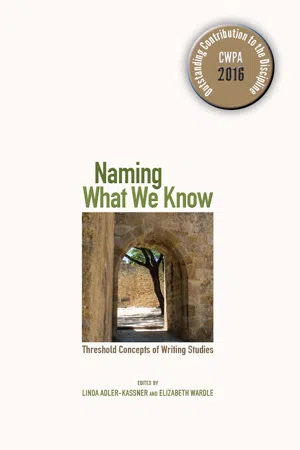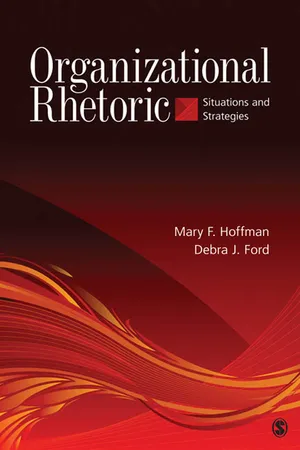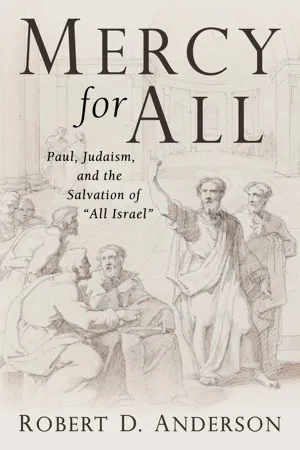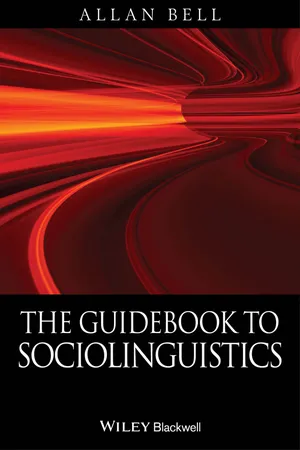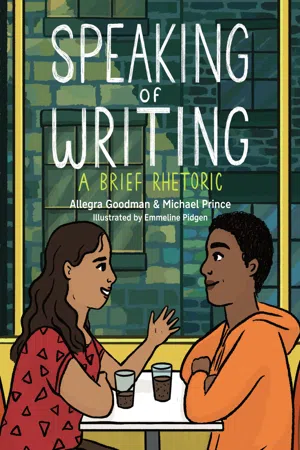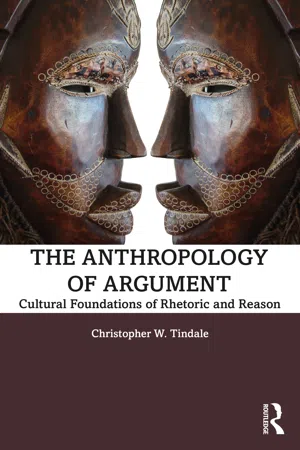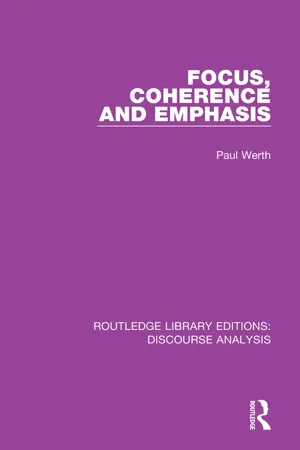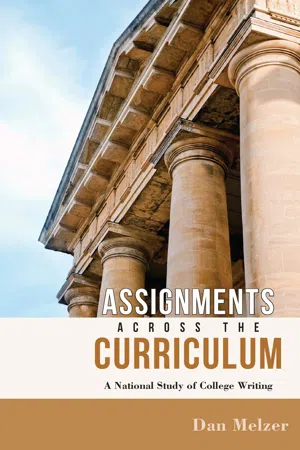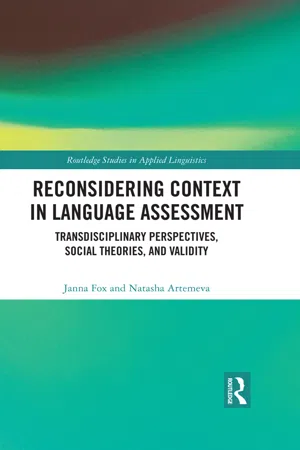Languages & Linguistics
Rhetorical Situation
The rhetorical situation refers to the circumstances in which communication occurs, including the audience, purpose, and context. It involves understanding the needs and expectations of the audience, the purpose of the communication, and the specific context in which the communication takes place. This concept is important in analyzing and creating effective language and communication strategies.
Written by Perlego with AI-assistance
Related key terms
Related key terms
1 of 4
Related key terms
1 of 3
10 Key excerpts on "Rhetorical Situation"
- eBook - ePub
Naming What We Know
Threshold Concepts of Writing Studies
- Linda Adler-Kassner, Elizabeth Wardle(Authors)
- 2015(Publication Date)
- Utah State University Press(Publisher)
Writing, as well, addresses social situations and audiences organized in social groups and does so through recognizable forms associated with those situations and social groups. But with writing we have fewer here-and-now clues about what the situation is, who our audiences are, and how we want to respond. Written messages can circulate from one material and social situation to another, and in fact are usually intended to. A newspaper report about events in one city is read in another, even in another country, and further events have evolved between writing and reading. A poem written for a small circle of friends is read centuries later in a literature classroom.The technical concept of Rhetorical Situation brings together recognition of the specifics of the situation, the exigency the situation creates, and our perception that by communication we can make the situation better for ourselves (Bitzer 1968 ). Awareness of Rhetorical Situation is the beginning of reflection on how we perceive the situation, what more we can understand about it, how we can formulate our goals, and what strategies we may take in our utterances. It helps us put in focus what we can accomplish in a situation, how we can accomplish it, and what the stakes are. But this awareness also puts a reflective distance between our perception of the situation and our responses, which may disrupt spontaneous impulses and our sense of being in the moment. This disruption can thus can be troublesome and require a fundamental reorientation toward our experiences, which we may at first resist. Recognizing we are being accused of misdeeds may make us aware we need to answer but also aware that we must frame our words carefully so as to defend ourselves persuasively and so as not to lead to further trouble or accusations.With writing, the need for understanding the Rhetorical Situation is even greater than in speaking because there are fewer material clues with which to locate ourselves spontaneously. To engage in a disciplinary discussion in chemistry, we not only need to know the chemistry, we need to know how each text is entering into a debate or accumulating past findings or projecting future plans (see 2.3, “Writing Is a Way of Enacting Disciplinarity”). It is through genre that we recognize the kinds of messages a document may contain, the kind of situation it is part of and it might migrate to, the kinds of roles and relations of writers and readers, and the kinds of actions realized in the document (see 1.2, “Writing Addresses, Invokes, and/or Creates Audiences,” and 2.2, “Genres Are Enacted by Writers and Readers”). Genre recognition provides a necessary clue for locating and making sense of any piece of paper or any digital display that comes before our eyes. Perhaps even more complexly, we may need to understand how documents move from among and between spaces, including from real spaces to enduring virtual spaces, which then may return to specific material spaces. So, teachers may collect records of students within a classroom for immediate classroom-management needs, but these records then may enter the school records for school-management purposes and then may be combined with school medical and other records to create a file on the student, creating an enduring characterization of the student that may reappear in a court proceeding. Thus, to understand the full range of situations a document in a particular genre may be used in and the full set of meanings that might be attributed to it, we also need to understand the activity system it is part of (Russell 1997 - eBook - ePub
Organizational Rhetoric
Situations and Strategies
- Mary F. Hoffman, Debra J. Ford(Authors)
- 2009(Publication Date)
- SAGE Publications, Inc(Publisher)
Situation or context has long been a key component of the study of communication. When people tell us something was said, we may ask them to explain the context in which it was said in order to help us understand what the comment might mean. Just as context is important in understanding communication in everyday life, it is also important in understanding how rhetoric works in organizations. In this chapter, we explore how two rhetorical scholars talk about the idea of situations, and look at how context is unique in organizations. We conclude by providing some specific instruction on how to research and analyze the Rhetorical Situation.Because rhetoric is strategic—created to address issues or solve problems—it is important that those studying rhetoric understand the contexts in which messages are created. Probably the best-known perspective on context and rhetoric is that of Lloyd Bitzer (1968), who coined the term “the Rhetorical Situation.”TWO PERSPECTIVES ON Rhetorical SituationSBitzer first introduced the concept of the Rhetorical Situation in 1968, and his work has been key in how rhetorical critics analyze and understand the circumstances in which rhetoric is created and received. In 1971, Richard Vatz challenged Bitzer’s perspective, and suggested a new way of understanding Rhetorical Situations. Each of these perspectives, though different philosophically, offers important insights for those who study or create organizational rhetoric. We first review Bitzer’s take on the Rhetorical Situation, and then explore Vatz’s challenge.Bitzer’s Perspective: Situations Call for RhetoricBitzer’s (1968) primary argument was that situations call rhetoric into being. In other words, situations exist in the physical and social world, and rhetoric is required to address them. He also argued that the situation itself determines what an appropriate and effective response will look like. It is the duty of the person creating the rhetoric to determine what kind of response will be able to resolve the situation. - eBook - ePub
Mercy for All
Paul, Judaism, and the Salvation of "All Israel"
- Robert D. Anderson(Author)
- 2023(Publication Date)
- Wipf and Stock(Publisher)
Hence, the Rhetorical Situation provides us with the framework of persons, events, relationships, etc., wherein the discourse exists and participates. The situation elicits, almost commands, the response of the discourse. That is, the discourse is grounded in the situation, not the rhetor or persuasive intent. We can summarize Bitzer’s idea that rhetoric is situational with the following seven characteristics of the relationship between the situation and the discourse: (1) “rhetorical discourse comes into existence as a response to a situation”; (2) “a speech is given rhetorical significance by the situation”; (3) “a Rhetorical Situation must exist as a necessary condition of rhetorical discourse”; (4) “many Rhetorical Situations mature and decay without giving birth to rhetorical utterance”; (5) “a situation is rhetorical insofar as it needs and invites discourse capable of participating with situation and thereby altering its reality”; (6) “discourse is rhetorical insofar as it functions (or seeks to function) as a fitting response to a situation which needs and invites it”; (7) “the situation controls the rhetorical response in the same sense that the question controls the answer and the problem controls the solution.” 475 Bitzer proposes three constituents of every Rhetorical Situation. 1. Exigence : An exigence is “an imperfection marked by urgency. .. a thing that is other than it should be.” If the “imperfection” cannot be modified (it comes about by necessity), then it is not rhetorical. If the exigence cannot be modified by rhetoric, then it is also not rhetorical. There will always be at least one controlling exigence that functions as an organizing principle, although it may not be perceived by either the rhetor or others in the situation. 2. Audience : To produce change, there must be persons who can mediate the change. This is the audience (or audiences) who creates the actions that bring about the change involved - eBook - ePub
- Allan Bell(Author)
- 2013(Publication Date)
- Wiley-Blackwell(Publisher)
6
SITUATED LANGUAGE
Language does not occur in a vacuum. It is situated, contextualized. There are speakers and hearers, a time and a place, a topic and a purpose. This chapter introduces the main ways in which sociolinguists have tried to describe and make sense of how everyday language is moulded by – and moulds – the situation of its usage.We then go on to examine several approaches to how language operates as part of interaction. The chapter deals with the use of language to do things through speech acts, and the ways in which politeness (or impoliteness) affects how we address another person. It looks in detail at the sociolinguistics of interaction, how that can lead to miscommunication between people, and the ways in which gender dynamics affect conversational patterns such as turn taking. Underlying this is a concern for the micro detail of everyday conversation that is informed by the methods and theories of anthropology, in particular by ethnographic approaches.6.1 SITUATIONS, CONTEXTS AND DOMAINS
A situation is the extended social occasion within which speech occurs (Hymes 1972). Situations are as variegated as human encounters – ‘card games, ball-room couplings, surgical teams in operation, and fist fights’, as Erving Goffman put it in a brief early paper on ‘the neglected situation’ (1964: 135). Language is one player in situation, although most situations are not primarily defined by language but by the shared activity. They may, however, contain conventional language elements, and speech may even be the main activity or prerequisite of what occurs. A committee meeting, a trial in court, a school class are all speech situations – they cannot in fact take place without speaking, and speaking that is appropriate to the specific situation. - eBook - ePub
- Allegra Goodman, Michael Prince, Emmeline Pidgen(Authors)
- 2019(Publication Date)
- Broadview Press(Publisher)
Rhetorical Situation.If people communicate all the time without thinking twice, why is it important to understand the Rhetorical Situation and its elements? First, rhetorical knowledge enables us to read critically, providing tools and vocabulary for evaluating texts and images. Second, rhetorical knowledge helps us to write effectively, as we consider the best way to convey a message to a particular audience. Let’s look more closely at the key elements of the Rhetorical Situation.PURPOSEPurpose is your motivation, the desire, the need that drives you to communicate. Sometimes rhetorical purpose is straightforward. You ask the waiter for a spoon, because yours fell on the floor and you need a clean one. Sometimes purpose is complex. When Martin Luther King Jr. wrote his “Letter from a Birmingham Jail,” he had at least two motives in mind—to argue directly with a group of ministers who advised against immediate protests against racial injustice and to make a larger statement defining human freedom and dignity. In each case, purpose drives communication.In college, your purpose depends on the assignment. Some assignments require you to inform. Reporting the results of a chemistry experiment, you inform your reader. Some assignments require you to persuade. You write a speech arguing for campaign finance reform. Still other assignments require a mix of information and persuasion. You set up an argument by informing your reader about previous research on campaign finance and the electoral system, and then you try to persuade your reader of your own viewpoint. There are those assignments which ask for a written analysis of a document or an image or an event or a data set. Alternatively, an instructor may ask you to entertain with storytelling, or to move your reader with poetry, or to spark debate with your reporting, or to provide a record of an event. The possibilities are endless, but in each case your purpose provides a reason or motivation - eBook - ePub
The Anthropology of Argument
Cultural Foundations of Rhetoric and Reason
- Christopher W. Tindale(Author)
- 2020(Publication Date)
- Routledge(Publisher)
Rhetorical argumentation draws on rhetoric’s opportunities to provide a more complete understanding of the argumentative experience, adding depth and thickness to what I will call the “argumentative situation.” Lloyd Bitzer (1968) brought rhetoric back to its contextual roots, insisting on its situational nature. Even logical threads of argumentation 2 have processed this insight, observing the shift between informal logic and its formal cousins, recognizing in context the conditions for “normal” argument that separate resolvable disagreements from those that are deep (Fogelin 1985). For Bitzer, rhetoric does something: it brings into existence a discourse that alters reality, called forth by a situation to which it responds, an exigence (4–5). Certain discourses, like those expressing extreme positions, throw this into disarray, marking boundaries of consensual response across which it is difficult to traverse. While not all such discourse is negative and much of it reflects the healthy diversity of opinions on which societies thrive, its presence still invites a fundamental rethinking of how rhetorical argumentation operates in circumstances characterized by dissensus (Kock 2007). Understood as positions of a radical nature that resist the status quo, extremist positions underlie many of our social and political debates and characterize the boundary lines that emerge between cultures. How are we to argue constructively with people who hold radical views in uncompromising ways? Many of the problems entangled in this question, problems of incommensurability and deep disagreement, are anticipated in the encounters that have occurred between peoples, societies, and cultures meeting for the first time. I adopt the concept “encounter rhetorics” 3 to describe the rhetorical and argumentative experiences characterizing these first-contacts - eBook - ePub
- Paul Werth, Paul Werth(Authors)
- 2016(Publication Date)
- Routledge(Publisher)
But what S-grammars cannot in principle account for is the relationship between an S and its surrounding discourse. We shall be arguing that such relationships are essentially semantic, though they may manifest themselves formally (in word-order or intonation, for example). We may now ask the question: what is the relationship between discourse and extralinguistic context (or "situation")?3.2 Review section: context-of-utterance
Informally, we can divide the context of an utterance into three broad types: The notion of context in linguistics is one that is invoked more often than it is discussed. Within linguistics, it is probably fair to say that more attempts to capture the idea have been made in Britain and Europe than in America. In American anthropology and sociology, however, a considerable amount of "programmatic" discussion has taken place. The comparative neglect in American linguistics, however, is presumably another heritage of Bloomfield. Most of the attempts to provide a descriptive framework - rarely more - for situation have concerned the immediate situation (or "setting"). In linguistics, at least, (and this is evidently true of both Europe and America), very little work on the cultural assumptions underlying a language in society has ever been attempted. We do not undertake to repair these discrepancies here. The following merely reviews, and occasionally suggests, directions of study.FIG. 3. 13.21 Immediate situationIn Britain, J.R.Firth's outline for studying the "Context of Situation" (Firth 1950), arose out of a need first formulated in anthropology to be able to describe the situations surrounding language. Its original formulator, Bronislaw Malinowski, saw this in terms of cultural assumptions (1930: 301 sqq.). Firth's system was as follows:- 2. A. The relevant features of participants: persons, personalities.
- The verbal action of the participants.
- The non-verbal action of the participants.
Firth's schema, though, apparently excludes cultural information, or rather, does not explicitly include it. Elsewhere, however, (e.g. 1935: see 1957: 32) he visualizes Context of Situation as embedded in the "Context of Culture". - eBook - ePub
The Persuasive Portrayal of David and Solomon in Chronicles
A Rhetorical Analysis of the Speeches and Prayers in the David-Solomon Narrative
- Ahn(Author)
- 2018(Publication Date)
- Pickwick Publications(Publisher)
2Rhetorical Situation
T he rhetorical situation is the context from which the rhetorical discourse arises. The rhetorical act depends on the Rhetorical Situation.218 The Rhetorical Situation of Chronicles can be traced by using the three components Bitzer suggested: exigence, audience, and constraints. However, we need to modify Bitzer’s concepts of Rhetorical Situation in that, as Vatz mentions, the rhetor can create exigencies and constraints, not merely controlled by the Rhetorical Situation.219 Accordingly, the rhetor as the author, which Bitzer has neglected, must be emphasized in the three components. In line with this, a rhetorical discourse may be understood from the relationship between the author and the audience.The Rhetorical Situation of a discourse has two levels: one is the text-world and the other is the author’s real world. However, we cannot know the actual author and the actual world of ancient texts like narrative discourse in the OT. Thus, the implied author as a literary construct is employed. If we presume the Chr is the implied author of Chronicles, the Chr’s own time can be traced by determining the date of the book of Chronicles. Accordingly, the determination of the composition date of Chronicles leads us to the Chr’s own time and audience. In this context, we need to recognize that there are two layers of audience in relation to a narrative discourse. Polzin refers to two types of audience in his study on Deuteronomy: the text-world audience and the original audience. The former is the audience to which Moses speaks on the plains of Moab and the latter the real audience of the author of Deuteronomy.220 - eBook - ePub
Assignments across the Curriculum
A National Study of College Writing
- Dan Melzer(Author)
- 2014(Publication Date)
- Utah State University Press(Publisher)
2 Limited Purposes, Narrow Audiences The Rhetorical Situations of College WritingStephen Wilhoit argues, “at the heart of every assignment is the Rhetorical Situation—someone writing to someone about something for some purpose” (Wilhoit 2002 , 62). From Lloyd Bitzer to Wayne Booth to James Britton, compositionists have focused on the composer and the audience as fundamental components of rhetorical acts. Although I also consider the broader contexts of genre and discourse community in my framework for analyzing the 2,101 writing assignments from across the curriculum in my research, the starting point for my analysis and the focus of the present chapter involves the Rhetorical Situation of purpose and audience.This chapter presents the results of an analysis of the purposes and audiences of writing assignments from across the curriculum in 400 different courses at 100 postsecondary institutions. Although I cannot generalize all college writing in the United States from my sample, I believe this chapter reveals a convincing—and often disappointing—pattern that speaks to the limited purposes and audiences instructors in my research assign.This chapter includes both the quantitative distributions of purpose and audience, and a textual analysis of representative assignments and related materials available on class websites, such as grading rubrics and course outcomes. Despite the limited Rhetorical Situations students are asked to address in college writing, the textual analysis reveals that the courses that demand of students some of the richest and most varied Rhetorical Situations are those courses connected in some way to a WAC initiative—a finding discussed more fully in chapter 5. - eBook - ePub
Reconsidering Context in Language Assessment
Transdisciplinary Perspectives, Social Theories, and Validity
- Janna Fox, Natasha Artemeva(Authors)
- 2022(Publication Date)
- Routledge(Publisher)
4). Looking back at this history, Tardy (2009) defined rhetorical knowledge as knowledge of “the intended purposes and an awareness of the dynamics of persuasion within a sociotheorical context” (p. 21). (See Rhetorical Genre Knowledge, Chapter Six.) Faigley (1995) considered some of the many possibilities afforded by “taking a social perspective” (p. 235) in writing research, alluding to a number of the theorists and theories, which are identified in some of the bracketed inserts below: Researchers taking a social perspective study how individual acts of communication define, organize, and maintain social groups [e.g., situated learning/communities of practice ]. They view written texts not as detached objects possessing meaning on their own, but as links in communicative chains, with their meaning emerging from their relationships to previous texts and the present context [ Bakhtin, 1981a, 1986 ] … [and] to consider issues such as social roles, group purposes, communal organization, ideology and finally theories of culture. [ Activity Theory /Vygotsky, 2012b ] (pp. 235–236) While the social turn in writing and discourse studies was underway, however, language assessment remained uneasily positioned and influenced by the dominant Discourses of the assessment-centred communities. There was only limited acknowledgement, knowledge of, or reflection on alternative, richly theorized perspectives on language as a social phenomenon. Shaped and informed by social theories and characterized by extensive accounts of context, language-centred communities such as discourse studies and writing studies tended to view language assessment as theoretically impoverished, misguided, threatening, and potentially undermining
Index pages curate the most relevant extracts from our library of academic textbooks. They’ve been created using an in-house natural language model (NLM), each adding context and meaning to key research topics.
Explore more topic indexes
Explore more topic indexes
1 of 6
Explore more topic indexes
1 of 4
